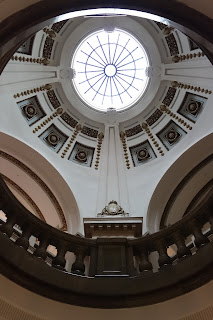Construction on Government House began in 1889 and at its completion in 1891 Government House was by far the most advanced dwelling in the North-West Territories. It boasted running water, which was pumped from a well in the basement to a collection tank situated in the attic, and then fed by gravity throughout the house. Sewage was directed from indoor flush toilets to a brick cesspool in the garden area and it was also the first residence in the Territories to be electrified. The Hon. Joseph Royal, Lieutenant-Governor of the North-West Territories 1888-93 was the first to live and work there and today Lieutenant Governor Vaughn Solomon Schofield has all of her working offices at Government House.
Government House - Regina
The Grand Ballroom
The Conservatory
The Drawing Room / Parlour
The Dining Room
One of many bedrooms
Grand entrance way / foyer
And then there's the beautiful Legislative Building in Regina. Construction of this majestic building started in 1908 and the building was officially opened in 1912 by His Royal Highness the Duke of Connaught,
This statue of Queen Elizabeth II and her favourite horse Burmese commemorates the Golden Jubilee of the Accession of Her Majesty to the Throne as Queen of Canada on February 6, 1952. Burmese was born and raised at Fort Walsh, Saskatchewan, and was presented to Her Majesty by the Royal Canadian Mounted Police in 1969. The Queen rode Burmese at the annual Trooping of the Colour until 1987.
Walter Scott, born near Strathroy, Ontario in 1867, went to the North-West Territories in 1896 and was elected to Federal politics in 1900. In 1905 Scott helped craft the legislation that created the provinces of Alberta and Saskatchewan and was appointed interim Premier of Saskatchewan until provincial elections could be held. Scott and his Liberals won the 1905 election and formed the first government of Saskatchewan. The Scott government chose Regina as the province's capital and began construction of the new Legislative Building. Believing that Saskatchewan would grow into one of Canada's most populous provinces, Scott wanted a structure that would last for centuries. The Saskatchewan Legislature was officially opened in 1912 and remains one of the largest Legislative buildings in Canada.
At only 250 metres long, the beam bridge spanning Wascana Creek is said to be the longest bridge over the shortest span of water. The bridge was a relief project during the Great Depression and was opened in 1930.
Trafalgar fountain, one of two fountains designed by Sir Charles Barry, architect of the House of Parliament in London, is located on the grounds of the Legislative building here in Regina. The two fountains stood in Trafalgar Square from 1845 to 1939, then to make way for a larger fountain, the original pair was donated to the National Gallery of Canada. In 1963 the British Head Commissioner to Canada dedicated this fountain to Regina in honour of the founding of the North West Mounted Police headquarters in 1882. Its mate is in Ottawa.
From the Legislative building, looking over Wascana Lake towards downtown Regina
Also on the Legislative grounds, the Saskatchewan War Memorial is a living memorial that pays homage to the Saskatchewan people who gave their lives in the two World Wars, the Korean War, and during military training and peacetime operations.
Although not totally visible in this photo, the pediment over the front entrance of the building is a carving entitled Progress featuring a female figure personifying Canada, with a new Canadian settler and his family to her left, and an Aboriginal man and woman to her right.
Painting entitled Northern Tradition and Transition, 2005 by Roger Jerome (for Saskatchewan's centennial)
Painting entitled Before The White Man Came, 1933 by John Leman
The Legislative Library houses many historic artifacts including this table reputedly used at the Quebec Conference in 1864 which led to the drafting of the British North America Act
Looking up into the domed ceiling
Legislative Assembly Chamber
And even here, on the Legislative grounds, there's still plenty of Saskatchewan's 'friends':


























No comments:
Post a Comment